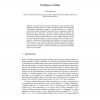Free Online Productivity Tools
i2Speak
i2Symbol
i2OCR
iTex2Img
iWeb2Print
iWeb2Shot
i2Type
iPdf2Split
iPdf2Merge
i2Bopomofo
i2Arabic
i2Style
i2Image
i2PDF
iLatex2Rtf
Sci2ools
TACAS
2014
Springer
2014
Springer
Variations on Safety
Of special interest in formal verification are safety properties, which assert that the system always stays within some allowed region, in which nothing “bad” happens. Equivalently, a property is a safety property if every violation of it occurs after a finite execution of the system. Thus, a computation violates the property if it has a “bad prefix”, all whose extensions violate the property. The theoretical properties of safety properties as well as their practical advantages with respect to general properties have been widely studied. The paper surveys several extensions and variations of safety. We start with bounded and checkable properties – fragments of safety properties that enable an even simpler reasoning. We proceed to a reactive setting, where safety properties require the system to stay in a region of states that is both allowed and from which the environment cannot force it out. Finally, we describe a probability-based approach for defining different levels ...
Algorithms | TACAS 2014 |
| Added | 25 Mar 2016 |
| Updated | 25 Mar 2016 |
| Type | Journal |
| Year | 2014 |
| Where | TACAS |
| Authors | Orna Kupferman |
Comments (0)

